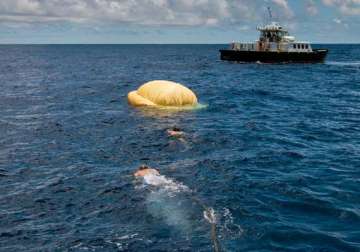Los Angeles: Sending heavier vehicles and, eventually, humans to Mars requires first testing new technologies to see if they actually work.
But it's infeasible to conduct experiments on the red planet, so to mimic Mars' low-density atmosphere, Nasa sent a saucer-like test vehicle high above the Earth.
Nasa engineers announced Friday that the June mission's main objective was met: The vehicle, called the Low Density Supersonic Decelerator, flew to 190,000 feet (57,900 meters) at more than four times the speed of sound and simulated Martian landing conditions.
“The vehicle did an amazing job of getting to the right speed and altitude,” said Ian Clark, principal investigator at Nasa's Jet Propulsion Laboratory.
The experimental flight, which cost about $150 million and was conducted from the U.S. Navy's Pacific Missile Range Facility on Kauai, Hawaii, was intended as a dry run for two more tests scheduled for next year.
One of the technologies Nasa engineers tested is an inflatable, doughnut-shaped ring around the edge of the saucer-like vehicle that deploys like a puffer fish in one-third of a second, slowing the vehicle. In the test run, the saucer went from traveling at Mach 4.3 - more than four times the speed of sound - to a breezy Mach 2, making the inflatable device a success, Nasa engineers said.
The second technology is a 100-foot-wide (30-meter-wide) parachute, which virtually disintegrated the moment it was released. In the months ahead, Nasa will try to figure out how to properly deploy the parachute, Clark said.
“The idea of taking 200 pounds of Kevlar and nylon and deploying it at 2,500 mph, 200 pounds that inflated would be the size of a small warehouse, is certainly a challenging endeavor. There's a lot of physics with this problem that we're now gaining new insights into that we've never had before,” Clark said. “And we're going to take all of that knowledge, and feed it toward our flights next year.”
Latest Business News
